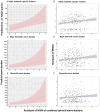Large-bodied gastric spirurids (Nematoda, Spirurida) predict structure in the downstream gastrointestinal helminth community of wild spiny mice (Acomys dimidiatus)
- PMID: 39320851
- PMCID: PMC11579037
- DOI: 10.1017/S0031182024000891
Large-bodied gastric spirurids (Nematoda, Spirurida) predict structure in the downstream gastrointestinal helminth community of wild spiny mice (Acomys dimidiatus)
Abstract
The dominant helminths infecting spiny mice (Acomys dimidiatus) in the montane wadis of the Sinai Peninsula of Egypt are spirurid nematodes, notably Protospirura muricola and Mastophorus muris. Both are relatively large robust stomach worms that accumulate in hosts resulting in high worm burdens. To ascertain whether the presence of spirurid worms or their burdens alters the host's likelihood of infection with other helminth species, we analysed a database containing quantitative data on helminth parasites of these mice (n = 431). This comprised of worm burdens recorded during 4 surveys, conducted at 4-year intervals, in 4 wadis, during late summer of each year. The presence of spirurid worms did not significantly alter species richness with other helminth species nor the likelihood of mice carrying other nematode species. However, there was a significant association, particularly of P. muricola, with the presence of intestinal stages of cestodes, and with the acanthocephalan Moniliformis acomysi. After controlling for intrinsic and extrinsic factors, mice harbouring spirurid worms had greater worm burdens of other helminths compared with mice without spirurids. Moreover, spirurid worm burdens showed a significant positive covariation with similarly adjusted species richness of other helminths, non-spirurid helminths, non-spirurid nematodes, oxyuroid nematodes and intestinal stage cestode worm burdens. We interpret these results as an indication that the key driver for co-occurrence of spirurids with other helminths is likely to be transmission via common arthropod hosts (for cestodes and acanthocephalans), but also that mice carrying the heavier spirurid worm burdens become more susceptible to directly transmitted nematodes such as the Oxyuroidea.
Keywords: Acanthocephala; Acomys dimidiatus; Cestoda; Nematoda; Oxyuroidea; Spirurida; arthropod-mediated transmission; associations and interactions between helminth species; spiny mice.
Conflict of interest statement
None.
Figures




Similar articles
-
Variation in the helminth community structure in spiny mice (Acomys dimidiatus) from four montane wadis in the St Katherine region of the Sinai Peninsula in Egypt.Parasitology. 2004 Sep;129(Pt 3):379-98. doi: 10.1017/s003118200400558x. Parasitology. 2004. PMID: 15471013
-
Intestinal helminths of spiny mice (Acomys cahirinus dimidiatus) from St Katherine's Protectorate in the Sinai, Egypt.J Helminthol. 2000 Mar;74(1):31-43. J Helminthol. 2000. PMID: 10831051
-
Long-term spatiotemporal stability and dynamic changes in helminth infracommunities of spiny mice (Acomys dimidiatus) in St. Katherine's Protectorate, Sinai, Egypt.Parasitology. 2019 Jan;146(1):50-73. doi: 10.1017/S0031182018000987. Epub 2018 Jun 20. Parasitology. 2019. PMID: 29921333
-
Structure in parasite component communities in wild rodents: predictability, stability, associations and interactions .... or pure randomness?Parasitology. 2008 Jun;135(7):751-66. doi: 10.1017/S0031182008000334. Epub 2008 Mar 27. Parasitology. 2008. PMID: 18371244 Review.
-
Helminth parasites of wolves (Canis lupus): a species list and an analysis of published prevalence studies in Nearctic and Palaearctic populations.J Helminthol. 2005 Jun;79(2):95-103. doi: 10.1079/joh2005282. J Helminthol. 2005. PMID: 15946392 Review.
References
-
- Barger MA (2023) Comparison of methods to detect interspecific competition among parasites in depauperate communities. Journal of Helminthology 97, e105. - PubMed
-
- Behnke JM, Wakelin D and Wilson MM (1978) Trichinella spiralis: delayed rejection in mice concurrently infected with Nematospiroides dubius. Experimental Parasitology 46, 121–130. - PubMed
-
- Behnke JM, Barnard CJ, Mason N, Harris PD, Sherif NE, Zalat S and Gilbert F (2000) Intestinal helminths of spiny mice (Acomys cahirinus dimidiatus) from St Katherine's Protectorate in the Sinai, Egypt. Journal of Helminthology 74, 31–44. - PubMed
-
- Behnke JM, Bajer A, Sinski E and Wakelin D (2001) Interactions involving intestinal nematodes of rodents: experimental and field studies. Parasitology 122, S39–S49. - PubMed
MeSH terms
LinkOut - more resources
Full Text Sources

